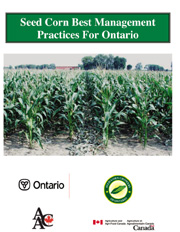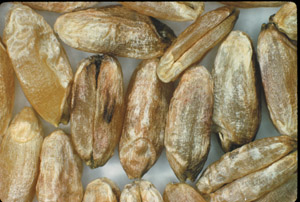
Features
Agronomy
Cereals
Managing red smudge in durum wheat
Although an infrequent problem, when this disease hits the quality loss can be dramatic.
April 8, 2008 By Bruce Barker
The most recent outbreaks of red smudge on durum wheat were in 2002 and 2004. In 2004, only a small percentage of the durum wheat crop graded No. 1, due to downgrading from red smudge. Since then, researchers have been working on best management practices to help minimize the disease.
 |
| Red, black and brown smudge, as well as blackpoint are evident in this sample. Photo Courtesy Of Canadian Grain Commission. |
Red smudge appears as a reddish or pinkish discolouration most often over the seed coat, and can also be accompanied by blackpoint. In the early 1990s, the Semiarid Prairie Agricultural Research Centre (SPARC) at Swift Current, Saskatchewan, conducted extensive research on red smudge. However, the need to deal with the emergence and spread of fusarium head blight diverted resources away from red smudge.
“Some of our research resources are moving back to red smudge control. We had put a lot of focus on fusarium head blight, but with climate change and unpredictable weather patterns, it is important to look into other diseases as well,” explains research scientist Myriam Fernandez, who works with Agriculture and Agri-Food Canada at the Semiarid Prairie Agricultural Research Centre at Swift Current, Saskatchewan. “To our knowledge, no other institution in the world is presently working on this important disease of durum wheat.”
Red smudge kernel disease is caused by Pyrenophora tritici-repentis. While this is the same fungal pathogen that causes tan spot, the most prevalent leaf spot disease of durum wheat in western Canada, tan spot and red smudge do not always appear together.
For example, tan spot might develop to high levels if there is good moisture during plant development, but if it is dry during kernel development, red smudge will not develop.
Conversely, if the weather is dry during early stages of growth, tan spot will be present at low levels or absent, whereas if it is wet later on during kernel development, red smudge might develop to high levels.
The biggest issue with red smudge is the effect on kernel discolouration. Louise Sartorio, manager of inspector training and development with the Canadian Grain Commission at Winnipeg, Manitoba, says that for a No. 1 Amber Durum, red smudge kernels cannot exceed 30 kernels per 500 grams, while total smudge and blackpoint combined cannot exceed five percent. The difference in the tolerance, she explains, is that smudge kernel discolouration affects the visual quality of the end product by causing specks in the semolina and pasta.
“Because the discolouration penetrates the bran and into the endosperm, and because the bran isn’t removed when making semolina, the discolouration can show up in the semolina as specks,” explains Sartorio. “The buyers want to see a nice yellow colour to the semolina and don’t want to see any visual contaminants.”
All types of smudge cause specks in the semolina. Blackpoint is confined to the germ and the surrounding area. The germ is normally removed prior to processing for semolina so there is less concern of this discolouration affecting the semolina than smudge.
Fernandez says that red smudge is a difficult disease to work with because its incidence and extent vary greatly from year to year. Because levels of naturally occurring red smudge infections in Saskatchewan are very low in most years, the researchers must simulate optimum environment under controlled conditions.
Red smudge on kernels most commonly develop when environmental conditions favour seed infection during kernel development. Seed infection is favoured during wet weather during grain filling. “You need a lot of humidity during kernel development for red smudge to occur,” explains Fernandez.
Management helpsFungicide seed treatments may protect germinating seed and young seedlings from seedborne pathogens. However, Fernandez says that seed treatments will not prevent the development of red smudge later in the season since the main source of inoculum for development of this disease is crop residue and sporulation on infected older leaves of the same crop.
 |
| Red smudge usually affects the entire bran of the kernel. Photo Courtesy Of Canadian Grain Commission (Louise Cooke, Grain Biology, Grain Research Laboratory). |
Also, the AAFC researchers have found that the tan spot/red smudge pathogen is not transmitted from infected seed to seedlings. Additionally, red smudge does not appear to affect seed germination either, but it may reduce seedling emergence and vigour. Under normal field growing conditions, grain yield is not likely going to be affected due to compensation caused by reduced competition among plants. Increasing the seeding rate is an option if seed infection levels are high. However, a higher seeding rate might increase the severity of tan spot on leaves later in the season due to higher moisture levels caused by a more dense leaf canopy.
Fernandez is also working on a new project established in late 2007, funded by the Canadian Seed Growers’ Association with support from Bayer, Syngenta and BASF, looking at finding ways to improve seedling vigour and emergence of red smudge-infected durum wheat. They are looking at chemical seed treatments to improve emergence and vigour of red smudge infected seeds, and biological control agents are being studied in collaboration with University of Saskatchewan microbiologist Vladimir Vujanovic to provide organic growers with seed treatment options.
Foliar fungicides are registered for tan spot application up to 30 to 45 days before harvest. However, the foliar application would not be allowed for red smudge control since it would infringe on the pre-harvest application interval.
One key management practice for red smudge control is to keep inoculum levels of the tan spot pathogen low during the growing season. This might not only increase yields but might also reduce the chances of red smudge developing later on if environmental conditions are favourable for infection by reducing the inoculum levels.
Crop rotation away from wheat for more than one year is one of the best ways of reducing inoculum levels of the tan spot fungus. Planting wheat on fields covered with wheat stubble or straw within two years of a previous wheat crop could result in increased chance of infection. Fernandez says that crop rotations with oilseed, pulse crops or fallow for more than two years will help reduce early season infections causing tan spot.
However, depending on environmental conditions, rotation may have little effect on infections late in the season because of the spread of windborne spores from neighbouring fields. It is also important to control volunteer wheat and grassy weeds in and around fields since they can serve as pathogen reservoirs.
“Often, two year old residue has more inoculum. For good control, you need at least two years of a non-cereal crop to reduce the local inoculum sources,” explains Fernandez.
No-till has also been shown to favour tan spot, since the wheat residues are left on the soil surface. However, despite wheat straw being the main source of inoculum, the soil moisture-saving benefits of conservation tillage will likely far outweigh the increased risk. Plus, the inoculum source would be better managed through crop rotation.
All registered durum wheat cultivars are susceptible to red smudge and tan spot, although there are differences among them in their reaction to tan spot. Provincial Seed Guides contain information on tan spot reaction.
Recent extensive screening has identified several genotypes with good resistance, the best of which will be incorporated into adapted backgrounds by SPARC durum breeders John Clarke and Danny Singh. Ongoing screening of some breeding lines has identified some with low levels of red smudge. Fernandez says that future work will involve further crosses and screening, in the hope that he and his colleagues will be able to develop a cultivar with both tan spot and red smudge resistance.
“Good resistance to red smudge is going to be difficult to find in durum wheat. I’m not sure if any even exists,” explains Fernandez. “It’s really frustrating work. We haven’t yet found very good sources for resistance, but will continue looking for it.” -end-
Grading definitions for smudge
Red smudge
Red smudge is a dark reddish discolouration usually associated with Amber Durum wheat. It often affects the entire bran of the kernel. Discolouration is not superficial and cannot be removed through abrasion.
Smudge
Smudge is a discolouration on the kernel, as a result of infection by some common field fungi. The discolouration may be brown, black or red.
Amber Durum
The discolouration is assessed as smudge in Amber Durum if:
1. More than half the kernel is discoloured, or
2. Discoloration of the crease:
- has spread onto the cheeks of the kernel regardless of any discolouration of the germ,
- appears as a thin line extending more than half the length of the crease, in combination with any discolouration of the germ.
Note: Kernels that have a thin line of discolouration of any length in the crease, but have no discolouration of the germ, are not assessed as smudge.
The CGC table shows the specifications for the different categories of smudge assessed:
• Red and total smudge specifications are the same in the top 2 milling grades of Amber Durum – 30K and 30K, one percent and one percent. The total of all the factors cannot exceed the maximum tolerance listed in the last column: Total smudge and blackpoint.
For example: In the No. 2, if you already have the limit of penetrated smudge or 0.25 percent, the maximum total smudge you could have is 0.75 percent (total of one percent) and then only nine percent of blackpoint (total of 10 percent). -end-
| Grade | Penetrated smudge |
Red smudge |
Total smudge |
Total smudge and blackpoint |
| No. 1 CWAD | 3K | 30K | 30K | Five percent |
| No. 2 CWAD | 0.25 percent | One percent | One percent | 10 percent |
| No. 3 CWAD | 0.5 percent | One percent | Three percent | 20 percent |